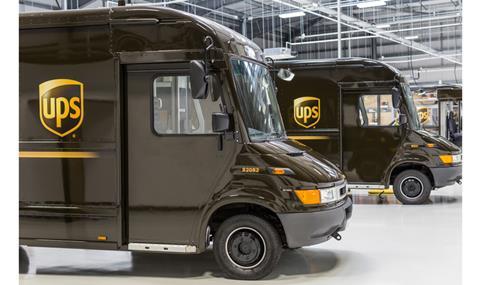
Burton upon Trent was once a global brewing superpower and although that heyday is behind it, the town has successfully reinvented itself, retaining its international flavour and attracting the likes of UPS.
The global operator opened its UK Integrad training facility in the Staffordshire town in May 2017, in a move echoing the same pursuit of excellence that saw the brewers of Burton achieve international prominence in the 19th century.
The facility, located near to the Clipper Logistics/Superdry site in the town and also home to Palletforce, is only UPS’s second in Europe (Cologne being the other).
There are, including these, 11 Integrad facilities globally, and the idea was born in the US in 2005. The UK facility formed part of a $2bn (£1.5bn) investment in UPS’s European network that was spent from 2014 through to 2019.
So what is Integrad? Essentially real-word training for new driving recruits and an acknowledgement within UPS that while the driving part of the job is essential, it is only one aspect of the role. Customer service, expressly how drivers interact with customers day to day, is also vital and something the operator believes sets itself apart from its competitors in what is a crowded field.
Read more
- UPS opens £120m DP London Gateway site as part of Europe-wide growth plans
- UPS to trial 35 all-electric Arrival trucks in London and Paris
- Mark Vale appointed president of UPS UK, Ireland and Nordics
“The driver role [within UPS] is frontline, bread and butter stuff. It’s what we do,” Bill Murphy, manager, UPS Integrad UK, and a key member in introducing the initiative to the UK, told MT.
“[The role is] not a typical driving job within our industry. There is a lot more customer interaction through our day,” he added, reinforcing that Integrad is not about teaching drivers how to drive but rather how to perform their role efficiently and safely.
The facility was a brownfield site but UPS is not a stranger to the region, having had a major presence in the East Midlands with a facility at East Midlands Airport (the company’s largest air gateway in the UK); a sortation centre in nearby Tamworth, which handles domestic freight and is the company’s second largest facility in the UK; and a freight and contract logistics facility in Coventry, for some time. Located in Burton, it is crucially within four hours’ travel of the majority of UPS’ UK locations too.
Integrad UK
The Integrad facility is unassuming from the outside, but once inside it resembles something akin to what you’d see in a Formula One garage, with a pristine, white floor and several polished UPS delivery vehicles housed in the central part of the building and serving as work stations. Classroom and function rooms are based off to the sides of the 15,000sq ft building that also features a mini-town test track out back so that drivers can learn the procedures that keep both them and the public safe – the site is 100,000sq ft in totality.

Integrad comprises of a series of stations that students over the course of a working week complete, typically with an assigned learning partner. It has the potential to train more than 1,000 students a year and Murphy is supported by five full-time instructors and a full-time site administrator.
Although you will find classrooms and conventional teaching conducted within - MT sits at a PC learning how to work UPS’s iconic handheld device, the DIAD 5 - the idea is very much about keeping people moving.
“Teach me, show me is what people want, so we have purposely reduced classroom time,” said Murphy.
MT gets to experience this on its visit. There is indeed a sit down hazard perception test at a PC that we try – and do poorly at – but even this will shortly be superseded with a VR headset to boost immersion if one suspects not our powers of perception.
Many other stations are physical and have you on your feet (although webcast modules feature
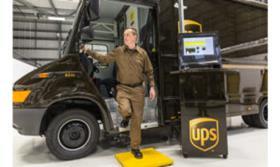
in the curriculum too). One station measures the force you are putting through your knees simply by stepping out of the car (as UPS call their distinctive vans) without the assistance of the handrail. For the average employee, based on the typical amount of delivery stops, that’s 6,491kg or three pick-up trucks a day. Multiply that up over a career of years – there is an image of a cruise liner representing 20 years - and that’s a whole lot of excess force that your joints and UPS as an employer would rather you avoid by simply using the vehicle’s handrail.
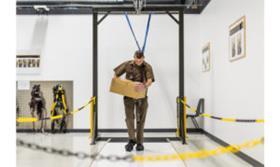
You can as you might imagine learn how best to pack parcels within the specially designed vehicle racking, but another station that leaves an impression, and supplies a few laughs for the watching instructors, is a low friction walkway. Students – and MT on this visit - are strapped into a harness and taught how to walk along the surface, which with a few modifications, becomes the equivalent of ice (walking like a penguin is the key to staying upright).
After all, just because the weather might take a turn for the worse, the delivery drivers of UPS are still expected to get people’s parcels to them.
Wellbeing is taught with warm-up stretches demonstrated and each student carrying their own water bottle from station to station too, as well as presentation. One of the stations is a shoe shinning stop because appearance is part of the professional image UPS sells as is attention to detail.
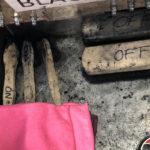
A cohort of students will typically number 24 for the week, and they are expected to rotate around the 13 stations within the facility, which comprise a variety of learning styles and promote teamwork, self-directed learning and problem solving.
Also, for a business all about time-sensitive deliveries where students will have a large amount of autonomy once out on the road, time management is baked into the process. There is no bell that sounds between allocated time for each station either, so if you run over you’ll be delaying colleagues. You need to be in the right place at the right time.
“In the real world something might happen and you’ll need to loop around to complete a particular delivery later,” Murphy explained.
“We cannot teach them everything. We are boosting their confidence and preparing them for day one of the job, when they will be given specific driver training,” said Murphy.
While the driver training programme comprises the majority of the facility’s calendar each year, three other curriculums that focus on management training and company car users take place.
So far 700 students have graduated from Integrad in the UK – 600 of these drivers - and while it can be initially overwhelming with plenty of information to filter, Murphy said that he, and the drivers that go through the process, ultimately get “a big sense of achievement”.
For an industry looking to keep its best employees and showcase its professionalism, Integrad is a powerful tool to ensure that those “integral to our success” as Murphy puts it, receive the best start to their UPS journey.
Toy town
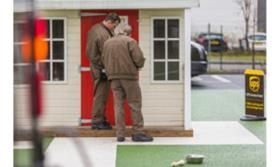
Outside the facility is a mini town, complete with roads, buildings and signals to allow students to put what they’ve learned into action. A quote from Aristotle, “We are what we repeatedly do” is printed on one of the classroom walls inside the facility, and the outside track is part of reinforcing good habits. MT is driven about the track by one of the instructors who demonstrates both a huge enthusiasm for the role and the correct sequence for registering the next stop in the DIAD, safe stopping, the careful exiting of the vehicle with parcel and the greeting expected at each point before then recording the delivery and preparing for the next. The level of detail
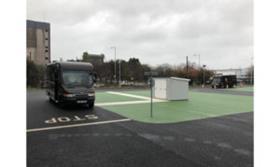
extends to a check under the van on return to it to ensure no small children or beloved pets have crawled under the chassis in search of a ball or shelter in the intervening time. The emphasis again is very much on learning by performing the tasks until they become second nature.
Images: MT and Andy Doherty from Doherty Photography











